
|
|

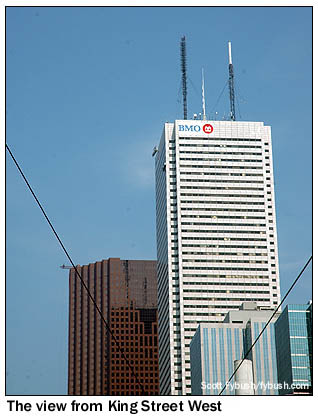 December 8, 2006
December 8, 2006
First Canadian Place, Toronto
It's been a while since we've visited a Canadian site here on Site of the Week, so what better time than a frigid December to look back at a sweltering summer day in Toronto's Financial District?
After many years of my looking longingly up at the city's (and Canada's) tallest skyscraper from street level, and occasionally down at it from the nearby CN Tower, Gus Sondermeyer of G.S. Broadcast Services kindly agreed to take me up to the top of First Canadian Place for a tour one afternoon in late May.
Unfortunately, it was not only a blisteringly hot day, but it was also the day that the union at the TTC, Toronto's mass transit system, decided to go out on a wildcat strike, so we ended up having to take rather a long walk in the smog from our hotel to the building - a small sacrifice for a great visit to one of North America's tallest rooftop sites.
First Canadian Place was built in 1975-76 on the site of the old Toronto Star building at Bay and King Streets. At 978 feet (298 m) to the top of the mechanical penthouse, it was the tallest building outside the United States at the time, and the Bank of Montreal logo at its top was the highest sign in the world. It was noted as well for its unusual stacked-cab elevators, which stop simultaneously at two floors of the building.
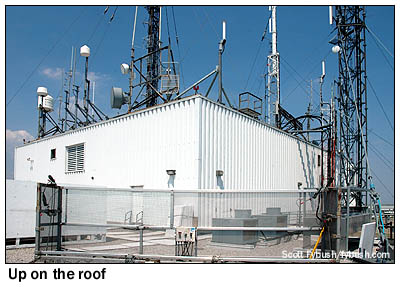 But
it's not the elevators we came to see - it's what the elevators
take us to, up at the top of the building. Without further ado,
let's move on to the broadcasting here:
But
it's not the elevators we came to see - it's what the elevators
take us to, up at the top of the building. Without further ado,
let's move on to the broadcasting here:
With the CN Tower just a few blocks away having already been topped out at 1815 feet (553 m) by the time First Canadian Place went up, one might not have expected this building to end up housing much in the way of FM and TV, and it wouldn't have, had the CN Tower been planned out to hold all the broadcasting that would come to the city over the ensuing decades.
But even with some expansions to its broadcasting facilities over the years, the CN Tower, as it turned out, had room for only six TV stations and ten FM stations, and Toronto's broadcast world has expanded far beyond that in the last three decades.
The first FM station to come up here, as far as I know, was CKO (99.1), the pioneering all-news FM station at the hub of what would become a nationwide network. It signed on from the east tower on the FCP roof on July 1, 1977, and remained here until the network folded in November 1989.
By then, an even taller tower had been built on the north side of the roof to house more FM signals (it tops out at 1164 feet), and within the last couple of years, another construction project has added a tower of similar height on the south side of the roof.
So who's up here now?
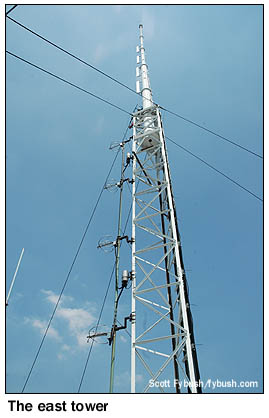
|
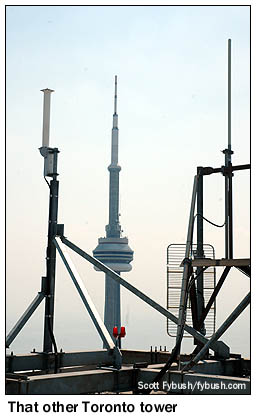
|
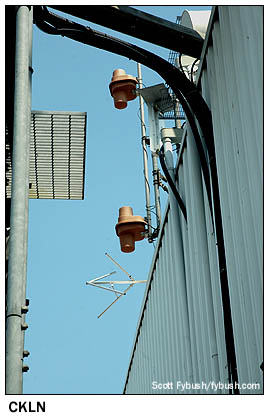
|
On the north tower (at left in the photo below), there's a single bay at the top that belongs to Fairchild's Asian-language CIRV (88.9). Below that is a six-bay Italian-made SIRA panel antenna used by two CBC FM stations, Radio One's CBLA (99.1), which signed on from here in June 1999, using the former CKO frequency and supplanting CBL (740), which signed off the following year, and French-language CJBC-FM (90.3), which moved here from the CN Tower a few years later. (The Radio Two outlet, CBL-FM 94.1, remains on the CN Tower master antenna system.)
 The
four-bay panel antenna below the CBC antenna belongs to "Jack
FM" CJAQ (92.5).
The
four-bay panel antenna below the CBC antenna belongs to "Jack
FM" CJAQ (92.5).
Below that is a one-bay Kathrein standby antenna for classical CFMX-FM-1 (96.3), and below that is CFMX's four-bay Kathrein main antenna.
The antenna mounted on the side of the east antenna (at the center in the photo at right, and better visible in the photo above) is the University of Toronto's CIUT (89.5), and the mast above that, which once held the CKO antennas, is available for new tenants.
The new south antenna (at right, in the photo at right) is topped by a UHF TV master antenna system. Its first occupants were two new stations that couldn't be accommodated at the CN Tower - "OMNI.2" CJMT (Channel 69) and "Toronto 1," now "Sun TV" CKXT (Channel 52). It now has DTV facilities for CKXT (on channel 66), and will soon be adding CJMT-DT (44) and sister station CFMT-DT (64) as well.
Below that is a one-bay antenna that's used as a backup for CILQ (107.1) and CFNY (102.1) when their main facilities at the CN Tower are off the air for maintenance. Below that is a two-bay antenna for CFXJ (93.5), the urban station known as "The Flow," then a two-bay antenna for Aboriginal Voices Radio's CFIE (106.5, since renamed CKAV) and another two-bay SIRA for multilingual CJSA (101.3). And there's room below that for one more two-bay FM as well.
Finally, there's college station CKLN (88.1), operating from a two-bay Shively mounted just above the mechanical penthouse roof, with what looks like a little Jampro next to that for backup use.
So that's the rooftop...now shall we head back down the ladder and have a look at some of the transmitter rooms inside?
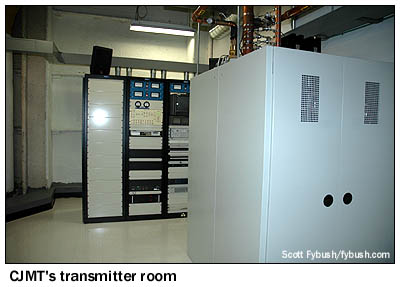
|
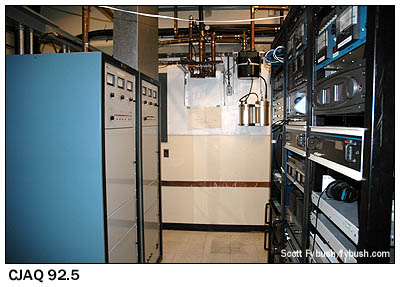
|
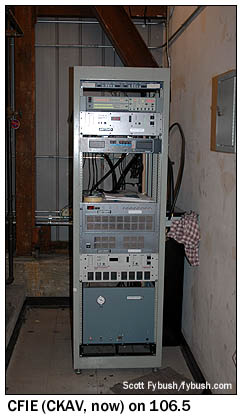 There's
no designated transmitter area on the mechanical floors here
- instead, there are a series of rooms squeezed in wherever space
permits around the generators, elevator machinery and other equipment
that keeps this building humming.
There's
no designated transmitter area on the mechanical floors here
- instead, there are a series of rooms squeezed in wherever space
permits around the generators, elevator machinery and other equipment
that keeps this building humming.
The first room we see isn't even a room, per se, just a section of floor fenced off for the use of Rogers' TV stations, CJMT (which uses a Thales transmitter that has its back turned to us in the photo above) and a big empty space reserved for CJMT-DT and CFMT-DT, with lots of RF plumbing already in place for them.
We walk past a locked closet that's home to CFXJ before entering another mechanical room, where there's a rack in one corner holding the CFIE (106.5) transmitter. Because the ERPs of many of these newer stations are so low (1.1 kW, for CFIE), there's not a lot of power needed at the transmitter end, so it's not uncommon to see just an exciter and a small rack-mounted power amplifier generating the few hundred watts that get sent upstairs to the antenna.
(Just as with the SIRA antennas on the roof, it's also not uncommon to see some European transmitter brands that aren't very often seen south of the border.)
Of course, there are also plenty of familiar-looking higher-powered rigs in use up here. Through another door, we enter a room that has the CJAQ (92.5) transmitters, a pair of Nautels shown above. CJAQ came on the air in 1993 as CISS, playing country music, and was later top 40 "Kiss" before becoming "Jack" in 2003.
In the next room, we see the CIRV transmitters, a Nautel auxiliary and a Continental 816 for the main, across from the Nautel and Harris transmitters for classical CFMX-FM-1 (96.3). Though it's nominally a satellite to the big CFMX (103.1) signal in Cobourg, 80 miles east, CFMX long ago moved its studios and most of its sales operation to Toronto, steadily upgrading the 96.3 signal from a little rooftop relay in suburban Mississauga to its current full-metro signal from up on the roof here.
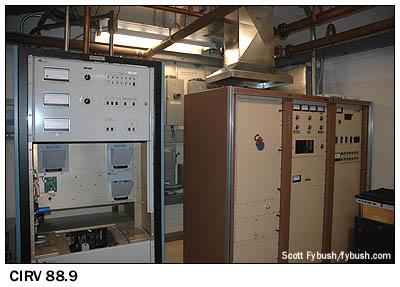
|
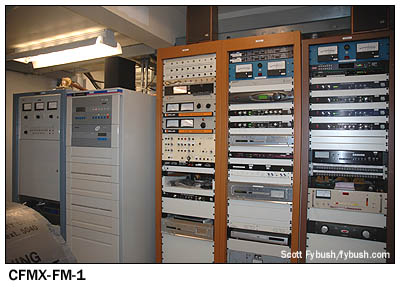
|
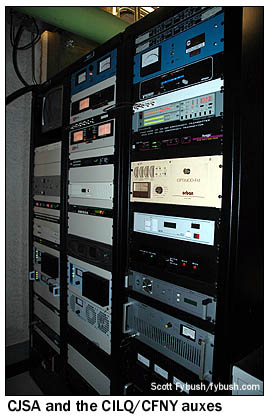 There's
another small room, not shown here, that's home to the Continental
transmitter for CIUT (89.5) and a small rack that holds the lower-powered
transmitter for CKLN (88.1).
There's
another small room, not shown here, that's home to the Continental
transmitter for CIUT (89.5) and a small rack that holds the lower-powered
transmitter for CKLN (88.1).
Another room holds relay transmitters for XM Canada and Sirius Canada, both of which have terrestrial repeaters on the roof.
There's a CBC room, behind a locked door, so we don't get to see the CBLA and CJBC-FM transmitters (someday!)
And there's one more room with a set of racks that hold the transmitter for the newest station here, Canadian Multicultural Radio (CJSA) at 101.3. It signed on in 2004, running just 850 watts ERP from those little SBS transmitters near the bottom of the two left-hand racks.
The rack at right holds emergency transmitters for CILQ and CFNY. (That's a Nicom at the bottom of the right-hand rack.)
With profound thanks (and a promise to come back when the DTV installation is finished), we head back down the elevator with Gus and out to join the masses of Torontonians walking the sweaty streets instead of riding the stalled-out TTC trains. (Later that afternoon, the strike would end and the subway began running again.)
And as we walked down King Street, we could look up to the roof and finally have some clue about what all those antennas up there were for!
 The Tower Site
Calendar 2007 is here! Get 'em before they're all gone -
order today at the Fybush.com
Store!
The Tower Site
Calendar 2007 is here! Get 'em before they're all gone -
order today at the Fybush.com
Store!
- Previous Site of the Week: WPLJ, Empire State Building, New York
- Next Week: Youngstown, Ohio
- Site of the Week INDEX!
- How can you help support Site of the Week? Click here!
- Submit your suggestions for a future Site of the Week!
